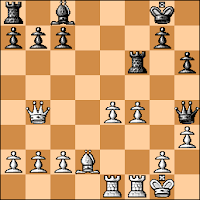
Although my personal statistic is a bit higher (9%), I have always thought of a draw as a "fire exit" for me, to escape from a game that has gone bad. I don't usually think of my opponents of being interested in splitting the point – they're usually too busy trying refute or destroy my plans to bother.
All of which explains some of the following game.
perrypawnpusher - frencheng
blitz FICS, 2010
1.e4 e5 2.Nf3 Nc6 3.Bc4 Bc5 4.Bxf7+
4...Kxf7 5.Nxe5+ Nxe5 6.Qh5+ Ng6
7.Qd5+ Ke8 8.Qxc5 Qe7
It's always a good thing if Black can get in ...Qf6 or ...Qe7 in a meaningful way.
9.Qe3 Nf6 10.Nc3 Kf7 11.0-0 Rf8
Black has just about castled-by-hand. As always, White has to make something of his "Jerome pawns" to keep in the game.
12.f4 d5
13.e5
White achieves less than nothing with the alternative 13.exd5 Qxe3 14.dxe3 Bf5.
After the game Rybka suggested a line to keep Black's advantage slight: 13.f5 Ne5 14.Nxd5 Nxd5 15.exd5 Qf6 16.d4 Nc4 17.Qd3 Nd6 18.Bf4 Kg8 19.g4 Bd7 20.b3 Rae8.
analysis diagram
13...Nh5
14.h3 Nxe5
Giving back the piece, rather than continue to deal with the penned in Knights. I think completing castling by 14...Kg8 was less committal.
15.fxe5+
First 15.Nxd5 was better.
15...Kg8 16.g4
It looks like White has found a way to capture the second Knight as well – but this move is actually a blunder. He would have done much better with 16.Rxf8+ Qxf8 17.d4, getting some development in before chasing the randspringer.
16...Rxf1+ 17.Kxf1 Bxg4 18.hxg4 Rf8+ 19.Kg2
19...Qd7
A solid move, but missing the direct and very useful pawn sacrifice 19...d4, as after 20.Qxd4 Black's attack builds with 20...Qh4 since the White g-pawn is pinned to its Queen. If White defends then with 21.Ne2 Black has the simple 21...Nf4+ followed by 22.Nxf4 Qxg4+ winning.
The un-supported ...d5-d4 isn't easy to see at first, but I am sure that my opponent would have been happy had he found it. Me, not so much.
20.gxh5
The position would still be complicated, but in White's favor, after 20.e6 Nf4+ .
20...d4
This was frencheng's plan to recover a piece.
He would have done better to sue for peace with: 20...Qg4+ 21.Qg3 Qf5 when White's three Queenside pieces look silly standing by doing nothing while Black's Queen forces repetitions of position.
21.Qg5
Willingly giving back one of the two pieces, but this was not the way to do it!
Simply 21.Qe4 dxc3 22.bxc3 and White is OK.
analysis diagram
21...Qc6+
Black is right – White's King is vulnerable – and the proper entry to the attack wins White's Queen (and more): 21...Qf7 22.Qg3 Qf1+ 23.Kh2 Rf2+ 24.Qxf2 Qxf2+ 25.Kh1 dxc3.
At the time the game was being played, I was clueless of the danger that my King was in.
22.Kg1 dxc3 23.bxc3 Qf3
24.Qg2
This is funny.
If I had seen 24.Ba3, opening up my Rook's protection along the first rank, I'd have found the win.
24...Qxh5
Temporarily missing the fire exit.
25.d4
Okay, this is ridiculous: it is the same error.
Again, 25.Ba3 wins.
25...Qd1+
My opponent heads for the exit and the safety of a draw.
26.Kh2 Qh5+ 27.Kg1 Qd1+ 28.Kh2 Qh5+ 29.Kg3 Qg6+ 30.Kh2 Qh5+ 31.Kg1 Qd1+ 32.Kh2 Qh5+ 33.Kg1 Qd1+ 34.Kh2
Game drawn by repetition.
graphic by Jeff Bucchino, the Wizard of Draws






























































